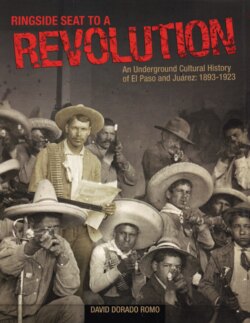Читать книгу Ringside Seat to a Revolution - David Dorado Romo - Страница 40
На сайте Литреса книга снята с продажи.
Оглавление“Mexicans.” On rare occasions, however, the Anglo
press did distinguish between “foreign-born
Mexicans”—meaning, oddly enough, Mexicans born
in Mexico!—and “American Mexicans.”66
Victor Ochoa was one of a small group of fron-
terizos around the turn of the century who was fully
bilingual. He was a naturalized U.S. citizen born in
Chihuahua in 1860 who had lived in Texas since the
age of three. His father, Juan Ochoa—a customs col-
ector at Presidio,
Texas—had used his
government post to
smuggle weapons for
Benito Juárez during
the war against the
French occupation of
Mexico. Victor’s news-
paper was in Spanish,
but later in life he also
wrote extensively in
English—editorials for
the El Paso Herald, sci-
entific articles about
flight for a New York
magazine, a tragicomic
short story entitled “The
Making of an American”
and an unpublished sci-
ence fiction novel set in
“Victor L. Ochoa is…
the boldest and most daring
off hand man I have ever
met and to me he appears
to be in his proper vocation
as a revolutionist.”
—Texas Ranger J. Fulgham
the times of the Aztecs, The Wise Man of the Land of
Moctezuma.
Victor began his insurrectionary activities by
printing recruitment flyers out of his newspaper
offices for “La División del Norte del Ejército
Revolucionario.” It was the same name that Pancho
Villa’s revolutionary troops would go by 20 years
later. The flyers offered $75 per month “to each indi-
vidual who presents himself with no less than one
hundred cartridges.” It offered twice as much for cav-
alrymen armed with rifle and pistol.
In the summer of 1893, revolutionaries operating
along the U.S.-Mexico border had asked Victor Ochoa
to lead a military expedition from El Paso. Ochoa
never revealed exactly who belonged to this group. It
may have been a revolutionary group headed by
Santa Ana Pérez—a former volunteer militia leader
who first fought with the federals against the
Tomóchic villagers, but then joined the rebels and
took up arms against his former allies. Or it may have
been Lauro Aguirre’s people. With funds provided by
this revolutionary group, Ochoa persuaded about 25
Mexicans from El Paso to join him. “We meant to
strike our first blow January 15, 1894,” Ochoa
explained. “I intended to concentrate 5,000 men near
Chihuahua and march against the Prefect of
Tomóchic first of all. To
avenge our families, our
loved ones, we intended to
hang him.”67
In January 1894, Ochoa
and his men joined forces
with a rebel described by
the local press as a “a
Tomochian named [Filomeno]
Luján,” who a few weeks
before had recruited about
65 men from San Elizario—
a small Texas town along
the Rio Grande southeast of
El Paso.68 Together, Ochoa
and Luján’s rebels raided
customhouses and federal
garrisons between Ojinaga
and Juárez shouting
“Remember Tomóchic!” and
“¡Muera Porfirio Díaz!”
Because Ochoa and many of his Mexican
American followers were U.S. citizens, the governor
of Chihuahua denounced Ochoa’s band as “cowboys”
and “foreign filibusters.”69 To stir up nationalist senti-
ment against them, the governor even accused the
revolutionaries of shouting “Long Live the United
States!” during their armed raids.
Ochoa’s attempt to get a revolution off the
ground ended in disaster. On January 21, 1894, his
forces were completely annihilated in the mountain-
ous terrain of Arroyo del Manzano, near Namiquipa,
Chihuahua. About 300 federal troops under the lead-
ership of Lieutenant Colonel Francisco Peinado
hemmed Ochoa’s forces on all sides.70 Ochoa saw his
men, although outnumbered, put up a gallant fight.
But at the end of the day nearly everyone, including
35
66
Things got even more confusing. “New Mexico Mexicans,” meant “American Mexicans” born in New Mexico.
67
“To Mexico for Revenge: Sent to Brooklyn for Filibustering, Ochoa Tells his Story,” New York Times, August 17, 1895.
68
El Paso Times, November 18, 1893.
69
“Blood Shed. Victor Ochoa Reported Routed Near Santo Tomas by Federal Troops,” El Paso Times, January 23, 1894.
70
“The Revolutionists: El Paso Man Writes the Story of Ochoa’s Battle,” El Paso Times, February 17, 1894. The Mexican government’s casualty
report for the rebels was 30 dead and 33 prisoners.
